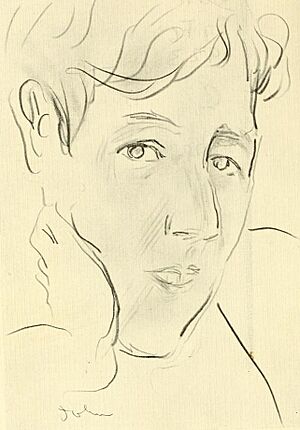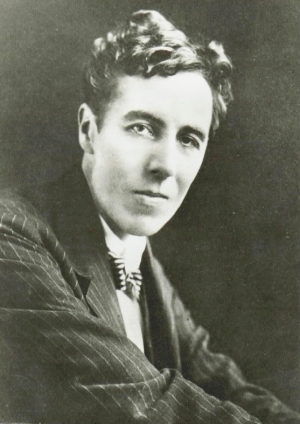Ronald Firbank facts for kids
Arthur Annesley Ronald Firbank (born January 17, 1886 – died May 21, 1926) was a creative English writer. He wrote eight short novels. These books were often inspired by artists in London in the 1890s, like Oscar Wilde. His stories mostly used conversations between characters. They also touched on topics like religion and people trying to improve their social standing.
Contents
About Ronald Firbank
Ronald Firbank was born on January 17, 1886, in Clarges Street, Westminster, London. His father, Sir Thomas Firbank, was a member of parliament. His mother was Lady Firbank.
Ronald had an older brother, Joseph, and a younger brother, Hubert. He also had a sister named Heather.
Early Life and Education
When he was 14, Firbank briefly attended Uppingham School. After that, he went to Trinity Hall, Cambridge University. In 1907, he became a Roman Catholic. He left Cambridge in 1909 without finishing his degree.
Travels and Later Life
Ronald Firbank lived off money he inherited from his family. He loved to travel. He explored countries like Spain, Italy, and places in the Middle East and North Africa.
He passed away in Rome, Italy, when he was 40 years old. He died from a lung disease. He is buried in the Campo Verano cemetery in Rome.
His Books and Plays

Firbank published his first story, "Odette d'Antrevernes," in 1905. This was before he went to Cambridge University. He then wrote several novels. Some of his books, like The Artificial Princess (written in 1915) and Concerning the Eccentricities of Cardinal Pirelli (1926), were published after he died.
Vainglory (1915) was his longest book. It was one of his first novels.
Stories from His Novels
His novel Inclinations (1916) mostly takes place in Greece. It follows a 15-year-old girl named Mabel Collins. She is traveling with her chaperone, Miss O'Brookomore. Mabel runs away with an Italian count. But the main focus of Firbank's books is always the interesting conversations between the characters. His next novel, Caprice, came out in 1917.
Valmouth (1919) is set in a health resort on the West Coast of England. Most of the people living there are very old, some even over 100! The story is about two elderly ladies, Mrs. Hurstpierpoint and Mrs. Thoroughfare. They try to arrange a marriage for Captain Dick Thoroughfare. This book became more popular in the 1960s. This was thanks to a musical comedy based on it in 1958.
After Valmouth, he wrote a story called "Santal" (1921). It tells the tale of an Arab boy looking for God. In his next novel, The Flower Beneath The Foot (1923), the story is set in a made-up country. This country is somewhere in the Balkans. The characters include a King, a Queen, and many high-ranking ladies and religious figures.
Sorrow in Sunlight (1924) was very popular in America. It is set in a Caribbean country. A black family who wants to be more socially important moves from their farm to the capital city. The story shows their attempts to join high society, which mostly do not work out.
His Play
Ronald Firbank also wrote a play called The Princess Zoubaroff (1920). It is not often performed. The famous actress Dame Edith Evans played the main character in a radio show in 1964. The play has very unique dialogue. For example, Princess Zoubaroff says: "I am always disappointed with mountains. There are no mountains in the world as high as I would wish... They irritate me invariably. I should like to shake Switzerland."
Collections of His Work
Firbank's Complete Short Stories were published in one book in 1990. His Complete Plays were published in 1991. This collection included The Princess Zoubaroff, The Mauve Tower, and A Disciple from the Country.
Ronald Firbank also left some unfinished writings. These included the first few chapters of a novel set in New York, called The New Rythum. These were published in 1962.
Main Published Works
- Vainglory (novel, 1915)
- Inclinations (novel, 1916)
- Caprice (novel, 1917)
- Valmouth - A Romantic Novel (novel, 1919)
- The Princess Zoubaroff - A Comedy (play, 1920)
- "Santal" (story, 1921)
- The Flower Beneath The Foot (novel, 1923)
- Sorrow in Sunlight (novel, 1924)
- Concerning the Eccentricities of Cardinal Pirelli (novel, 1926)
- The Artificial Princess (novel, published 1934, written around 1915)
- The New Rythum and Other Pieces (novel fragment and other writings, published 1962)


